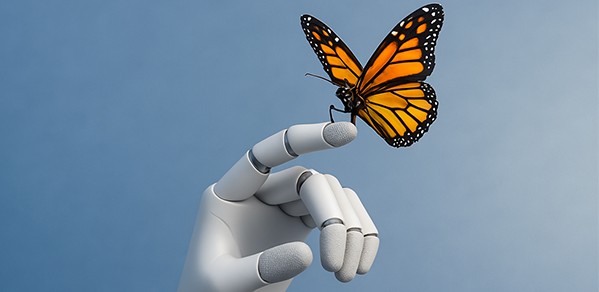
The UK’s Advanced Research and Invention Agency (ARIA) has launched a £57 million initiative to revolutionise robotic capabilities and deliver a step change in human productivity. Cambridge researchers will lead three projects developing new forms of tactile perception, control strategies and co-evolving robot designs.
Bridging the gap in robotic dexterity
The UK’s Advanced Research and Invention Agency (ARIA) Robot Dexterity programme aims to overcome the current limitations of robotic manipulation by supporting breakthroughs in sensing, materials, control and machine learning.
Funding has been awarded to 25 research teams over 26 projects – one team is working on two projects – from start-ups, universities, public research institutions and major companies. The projects represent an array of cutting-edge research across robot hardware and advanced simulation, with the ambition to usher in a new era of dexterity.
A collaborative approach to innovation
Led by Professor Jenny Read, a founding programme director at ARIA and a professor of vision science at Newcastle University, the initiative reflects ARIA’s focus on high-risk, high-reward research. Rather than supporting incremental improvements, ARIA encourages bold, interdisciplinary ideas that could unlock new levels of robot adaptability and control.
By fostering collaboration between scientists, engineers and industry partners, the programme is helping to bridge the software-hardware divide in robotics and accelerate the deployment of next-generation systems.
Cambridge leads in advanced robotic perception
Among the standout contributions are three projects based at the University of Cambridge, where researchers are developing new forms of tactile perception, control strategies and co-evolving robot designs.
Professor Tawfique Hasan: Pioneering electronic skin for robots
One of the Cambridge-led projects focuses on next-generation electronic skin (e-skin) to improve robots’ ability to perceive and respond to their environments. Professor Tawfique Hasan, Head of the Nanoengineering Group, at the Electrical Engineering Division in the Department of Engineering, leads this work with a team combining expertise in nanomaterials, sensors and robotics.
Drawing on years of research in nanomaterials, the group is designing e-skins with miniaturised sensors that detects force in three dimensions and temperature in real time. The goal is to give robots a sense of touch that approaches human capability – critical for manipulating delicate objects or operating in unstructured environments.
“We are focused on designing e-skin systems that offer high sensory density, large coverage and superior force sensitivity,” said Professor Hasan. “The integration of advanced nanomaterial-based sensors into robotic systems is a significant step towards developing robots capable of performing complex, force-sensitive tasks.”
The project brings together Dr Guolin Yun, an expert in liquid metal systems and robotic sensor integration, and Dr Zhuo Chen, a specialist in sensor array fabrication and commercialisation. With additional expertise in electronics and system testing, the team is working to translate their lab-scale technologies into scalable solutions for industry.
Professor Fumiya Iida: Advancing dexterous tool use with tactile sensing
A second Cambridge project, led by Professor Fumiya Iida from the Department of Engineering, is developing a scalable and flexible tactile sensing system based on Electrical Impedance Tomography (EIT). This system is designed to support real-time, closed-loop control for robots performing force-sensitive manipulation tasks – such as using scissors, screwdrivers or chopsticks.
“Advancing the manipulation of tools with robots is a key challenge,” said Professor Iida. “Our work will push the boundaries of what robots can do, making them more adaptable and capable of performing a range of sensitive tasks traditionally reserved for humans.”
The team aims to optimise key performance metrics – high sensory density, broad coverage, fast response times and robustness – while ensuring compatibility with existing robotic platforms. The long-term goal is to enable reliable, scalable tactile systems that can be widely deployed across sectors.
Dr Rika Antonova: Co-evolving smarter robot bodies and learning
Dr Rika Antonova, also based at Cambridge in the Department of Computer Science and Technology, is rethinking how robots learn and adapt to the physical world. Her project – Adaptive global optimisation for co-evolving hardware and policy learning (Ada-GO) – is developing a framework where robot bodies and control algorithms evolve together, guided by real-world performance data.
“Robots still struggle with many real-world tasks like recycling, agriculture and care work,” said Dr Antonova. “We want to speed up how they learn to be useful, reliable and affordable.”
Rather than relying solely on simulation, the team is building a hardware-in-the-loop system that allows both mechanical components and machine learning policies to evolve iteratively. By using global optimisation, the system explores new configurations of structure and behaviour – paving the way for more dexterous and efficient robots.
Key applications include autonomous science labs, disassembly and recycling, and assistance for ageing populations. “By 2050, there will be 1.6 billion people over 65,” Dr Antonova said. “Dexterous robots could support independence and reduce pressure on care services.”
Dr Antonova brings experience from academic roles at Stanford, KTH and Carnegie Mellon, as well as work at Google where she helped scale AI systems from research to real-world use. “We need teamwork across different universities, companies and disciplines,” she added. “ARIA has done an amazing job of bringing us together – and I believe this is the key to the programme’s success.”
Shaping the future of dexterous robotics
These Cambridge-led projects, alongside others funded through ARIA’s Robot Dexterity programme, could transform how robots operate across healthcare, manufacturing, environmental services and even space exploration.
By supporting interdisciplinary research in tactile sensing, control and machine learning, ARIA is advancing the UK’s leadership in robotics and AI. The Agency’s bold, collaborative model is already setting the stage for a new generation of smarter, more adaptable machines.
Groundbreaking robot dexterity projects
ARIA’s Robot Dexterity initiative supports innovative research projects exploring new frontiers in robotic capability. Read the full programme online.
This article first appeared on the Electrical Engineering at Cambridge website – written by Michael Shuff.

